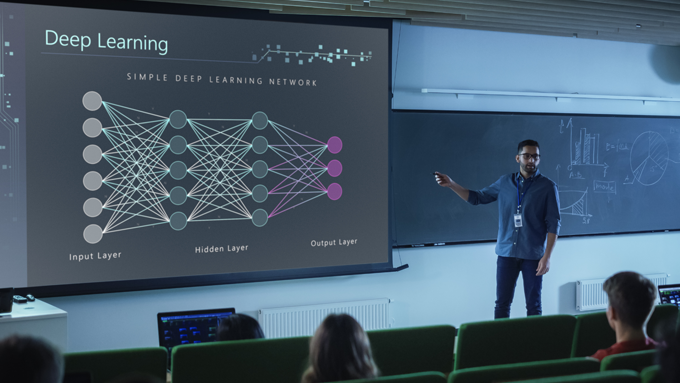Teaching and Learning in the Context of AI

The University of Alberta (U of A) is committed to supporting you in navigating the evolving landscape of artificial intelligence (AI) in higher education. AI and Generative AI (GenAI) technologies allow you to enhance teaching practices and improve student learning while using the tools ethically and responsibly. As GenAI advances and our understanding of GenAI grows, these pages will be updated, and resources will be added.
While GenAI may reshape aspects of teaching, core educational principles and goals remain unchanged. As with past technological innovations, these tools should enhance rather than replace–the student learning experience. You remain central to fostering human interaction, building a sense of community and promoting engaged, active learning through guidance, facilitation, feedback, thoughtfully designed activities, and assessments.
This website explores practical strategies for integrating or addressing GenAI into your teaching and learning practice aligned with the University of Alberta's Framework for Effective Teaching.
The U of A Steering Committee on AI has launched a “Using Artificial Intelligence at the U of A” information webpage. The site's goal is to provide a central area for sharing AI-related information and resources for the U of A community, including the draft Framework for Responsible & Ethical Use of AI at the U of A.
This web resource will evolve alongside the technologies it describes.
Updates & Announcements
Jan. 14, 2025 | Getting started with Gemini App

About Generative AI
GenAI tools are a rapidly evolving landscape. As these technologies continue to develop, their impact on higher education will likely expand and shift in anticipated and unexpected ways. Explore key categories of GenAI tools, outlining their capabilities, potential educational applications, and critical considerations for classroom use.
Learn more

AI and Academic Integrity
Explore key principles and strategies to support academic integrity, including how to address the risks associated with AI use. Instructors are responsible for setting clear expectations and fostering transparency to help students understand academic integrity within your course.
Learn more

Students and AI
Given that students navigate varying levels of GenAI use, AI literacy, and tool access across their courses, it's essential to clearly and consistently communicate your specific expectations about AI tool usage throughout the semester, both in your Statement of Expectations and during regular course discussions.
Learn more

Course Design and AI
Effective course design starts with clear learning outcomes that define what students should achieve and guides the development of activities, materials and assessments. Reflecting on technology use ensures GenAI is integrated responsibly and ethically, aligning with learning outcomes, which vary across disciplines, course levels, and learning contexts.
Learn more

Assessment Design
Instructors will likely feel the greatest pressure to adapt to GenAI in assessment tasks such as assignments, tests, and exams with varying approaches shaped by specific teaching, learning, and disciplinary contexts. Assessments must promote academic integrity while fostering critical thinking, ethical reasoning, independent problem-solving, and essential learning.
Learn more

Instructional Practice and AI
Instructional practice allows instructors to demonstrate responsible (and ethical) GenAI use. Instructors can illustrate the range of ways AI may or may not be used to build course-specific knowledge, skills, and outcomes. Equitable and inclusive teaching practice includes discussing access to GenAI tools and AI’s relation to copyright, human rights, and the environment.
Learn more

Suggested Resources
When adapting assessments to address GenAI, instructors must establish clear expectations that promote academic integrity, critical thinking, and equitable access while considering their specific teaching contexts and disciplinary needs.
Learn more
Share your ideas
CTL welcomes collaborators! We invite instructors to share their experiences with GenAI in teaching and learning to help build an AI-aware university community. Together, we can explore ways to enrich student learning while upholding academic integrity. Join us in expanding the U of A’s collective knowledge by sharing insights and examples from your courses using the Collaboration Form. Alternatively, you can share your examples with us directly via email ctl@ualberta.ca.